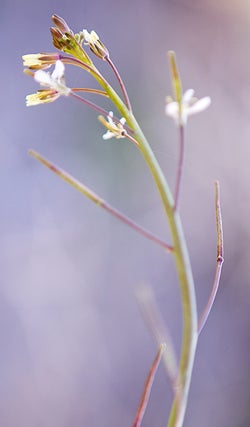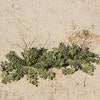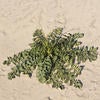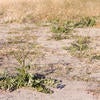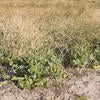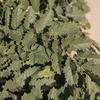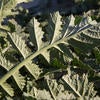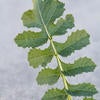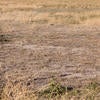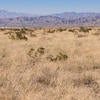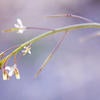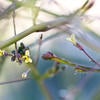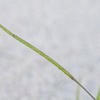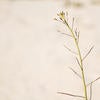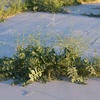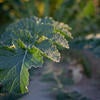Sahara Mustard, Brassica tournefortii
The situation. Deserts have long been considered relatively impervious to plant invasions. In the southwestern U.S., the list of serious desert invaders is not long and includes a few grasses, such as European split-grass (Schismus barbatus) and red brome (Bromus rubens), wild geranium (Erodium cicutarium), and most recently, Sahara mustard (Brassica tournefortii). Although this list is short, the impacts to native biodiversity may be very large. In the Mojave Desert these species have fueled wildfires in ecosystems where native species lack adaptations to survive those fires. In the last couple of decades the recent invader Sahara mustard has spread rapidly across the desert landscape, causing desert land managers and others to wonder whether anything can be done to stem its rapidly expanding range.
Impact. As a recent invader, little is known besides anecdotal observations about the impacts of Sahara mustard in southwestern deserts. A critical question is whether there will be any long-term impacts on biodiversity from the mustard invasion. In 2005, with the help of volunteers from the US Bureau of Land Management, UCR researchers established a series of 0.1 ha plots (about ¼ acre, or roughly the size of 2 suburban residential lots). On half of the plots (15), Sahara mustard was removed by hand-weeding (treatment plots); the other half of the plots were left alone to measure the effect of Sahara mustard (control plots). Results were dramatic. On control plots containing Sahara mustard, native wildflowers germinated in numbers similar to those in weeding treatment plots, but underneath the dense canopy of Sahara mustard the natives grew taller, putting energy into height growth, and produced very few flowers or seeds. There was a 90% reduction in the natives’ reproductive success on the control plots (measured in numbers of flowers and seed pods) compared to the weeding treatment plots. This pattern also included an endangered plant species, the Coachella Valley milkvetch (Astragalus lentiginosus var. coachellae). Later in the early fall of 2005 nearly 5 cm (2 inches) of rain fell, resulting in more Sahara mustard emergence as well as emergence of more native annual plants. Measurements on the plots were continued to determine whether the effect of weeding Sahara mustard would last more than one season. Up to two growing seasons after hand- weeding, even without further treatments, there were still (slightly) more natives and less Sahara mustard on the plots that were weeded in 2005. Results of this experiment show that with Sahara mustard densities present in the Coachella Valley (sometimes > 300 plants/m2), the negative effect of this weed on native annual plants can be severe. If conditions such as those of this experiment (rainfall and Sahara mustard densities) continue, the native annual plant seed bank will become increasingly depleted, and native annuals will become increasingly scarce, and Sahara mustard will become more and more dominant.
Distribution. Sahara mustard was first collected and deposited as a herbarium specimen in 1927, although it was initially misidentified as the wrong species of mustard. Andrew Sanders, Curator of the University of California, Riverside Herbarium, discovered the mistake, provided a correct identification, and then plotted Sahara mustard’s path of invasion. That 1927 specimen was collected from southern California’s Coachella Valley, likely the result of an inadvertent introduction, hitching a ride along with palm trees imported from northern Africa when the Coachella Valley’s now thriving date industry was just beginning. Years went by, and despite active plant collecting few additional Sahara mustard specimens were recorded. Then during a series of strong el Niños in the late 1970s and early 1980s, Sahara mustard started appearing across the desert region. The first herbarium specimen of Sahara mustard collected near Tucson, Arizona was found in 1978; it was considered rare until 1991 and then abundant by 2005. In the Coachella Valley Sahara mustard was widespread during the particularly wet years of the late 1970s and early 1980s. The species seemed to return to obscurity until the next strong el Niño condition of 1994-1995, when it again appeared widely across the desert valley floor. In the late 1990s it once more was uncommon, even during a particularly good wildflower year of 1998, but it returned in 2005, and again in 2008, 2009 and 2010, and now appears likely to remain a part of the desert landscape.
Research on biology and ecology. Research conducted at UCR has helped explain why Sahara mustard is successful in desert ecosystems. Interestingly, black mustard (Brassica nigra) and shortpod mustard (Hirschfeldia incana) are dominant, closely related species, also not native to the U.S., that have overlapping but dissimilar distributions; neither has been found in the desert. Sahara mustard is rapidly spreading in warm deserts of the southwest, while black and shortpod mustard are primarily limited to coastal and non-desert inland regions. Research was conducted both at UC Riverside (inland environment) and in Blue Diamond, Nevada (desert environment) to compare traits of these three mustard species as well as desert and non-desert populations of Sahara mustard to determine why Sahara mustard is able to spread into desert environments. Results showed no evidence for selection of desert-adapted Sahara mustard ecotypes, and no enhanced ability for this weed to survive in desert conditions. However, Sahara mustard germinated, emerged, and grew faster and flowered earlier than black and shortpod mustard under all conditions. Thus, it demonstrated more rapid phenology than the other two mustard species that do not occur in the desert. Although they are more successful in milder, mesic ecosystems, black and shortpod mustard may be limited by their ability to reproduce in the more arid desert niche. Similar research conducted in desert field sites showed that Sahara mustard had earlier phenology than several native annual species, as well. Under field conditions this trait could allow Sahara mustard to avoid drought by completing its life cycle during cooler, wetter winter months, avoiding the necessity to tolerate drought. Rapid phenology allows Sahara mustard to reproduce consistently under variable, stressful conditions such as those found in southwest deserts.
Research on methods of control. Exotic annual plants are an increasingly important ecological issue in deserts and new, creative approaches to management are required. Hand-weeding Sahara mustard is currently the most common control method employed, but weeding is inadequate when plants are mature, and not feasible for managing large-scale invasions. Earlier phenology of Sahara mustard than natives suggests that a window for selective control of this weed, and perhaps other exotic annuals, may occur immediately after seedling emergence. Research was conducted by UCR scientists to test whether the more rapid germination and phenology of Sahara mustard compared to native annuals could be used to control this weed without impacting natives. The role of timing in applying weed control to Sahara mustard was tested by comparing an early cotyledon-stage glyphosate application (i.e., a herbicide was applied), a later bolting-stage glyphosate application, hand-weeding, and no control (an untreated check). Treatments were tested at two sites dominated by either exotic or native annuals and followed for two years; the early application was repeated in additional plots the second year. Results showed that early-stage herbicide application did not affect native plant cover but did reduce exotic plant cover. In contrast, late-stage herbicide applications negatively impacted both exotic and native species. Although Sahara mustard was controlled, native species had little positive response to any treatments and only in the hand-weeded treatments under shrubs, but the same treatment caused an increase in the exotic plant filaree (Erodium cicutarium) at one site. Thus, it is possible that rapid phenology of exotic annuals may be exploited for weed control while minimizing impacts on native plants in desert communities. This approach may be useful for other invasions in other ecosystems by species with rapid, early germination, or may act as a supplement to improve the efficacy of existing management regimes.
Control of Sahara mustard over vast, multi-state desert acreage will be especially challenging. Hand weeding is a great way to engage a community of concerned citizens, but considering the acres infested, its impact can only be narrow in scope, and perhaps best suited to areas of high conservation concern. Where it is practiced, the problem remains of how to remove and dispose of Sahara mustard biomass. The best hand-weeding strategy currently is to select locations of reasonable size where examples of spectacular desert flora can be maintained, such as in the Anza Borrego State Park. Biological control agents that can reduce Sahara mustard population growth have been suggested for suppressing Sahara mustard. However, finding a suitable biocontrol agent in the native range of this species, conducting the research necessary to demonstrate the agent’s safety, and obtaining approval for its release is difficult, expensive and time consuming. The relatively close genetic relationship between Sahara mustard and a suite of important agricultural crops (broccoli, cabbage, canola, etc.), which could also be impacted by a mustard biocontrol agent, especially a plant eating insect, will make the task of finding a biocontrol agent that will only feed on Sahara mustard and no other closely species even more difficult. As discussed above, another option could be the judicious use of fast-degrading herbicides applied at time when the weed is most sensitive to applications and native plants are not at risk. Sahara mustard usually germinates a month before natives do, offering a potential window for any control efforts. There are no easy options, but there is currently a strong public will to find a solution.
More Media on Sahara Mustard
"Effects of an invasive plant on a desert sand dune landscape" Barows, C. W., E. B. Allen, M. L. Brooks, and M. F. Allen. 2009.
"Controlling Sahara mustard: evaluation of herbicide and mechanical treatments (California)." Ecological Restoration 24: 277-278. Brooks, M. L., J. V. Draper, and M. R. Trader. 2006.
"Brassica tournefortii: Phenology, Interactions and Management of an Invasive Mustard." Robin Marushia, Ph.D. Dissertation, University of California, Riverside
"Phenology as a basis for management of exotic annual plants in desert invasions." Journal of Applied Ecology 47: 1290-1299. Marushia, R. G., M. W. Cadotte, and J. S. Holt. 2010
Center for Invasive Species Research, University of California, Riverside
Text provided by: Jodie S. Holt, and Cameron W. Barrows
Photos provided by Mike Lewis and Cameron W. Barrows
Jodie Holt, Chair & Professor of Plant Physiology & Plant Physiologist
jodie.holt@ucr.edu
Cameron W. Barrows, Assistant Researcher
cameron.barrows@ucr.edu
Media within CISR is licensed under a Creative Commons Attribution-NonCommercial-NoDerivs 3.0 Unported License. Permissions beyond this scope may be available at www.cisr.ucr.edu/media-usage.

